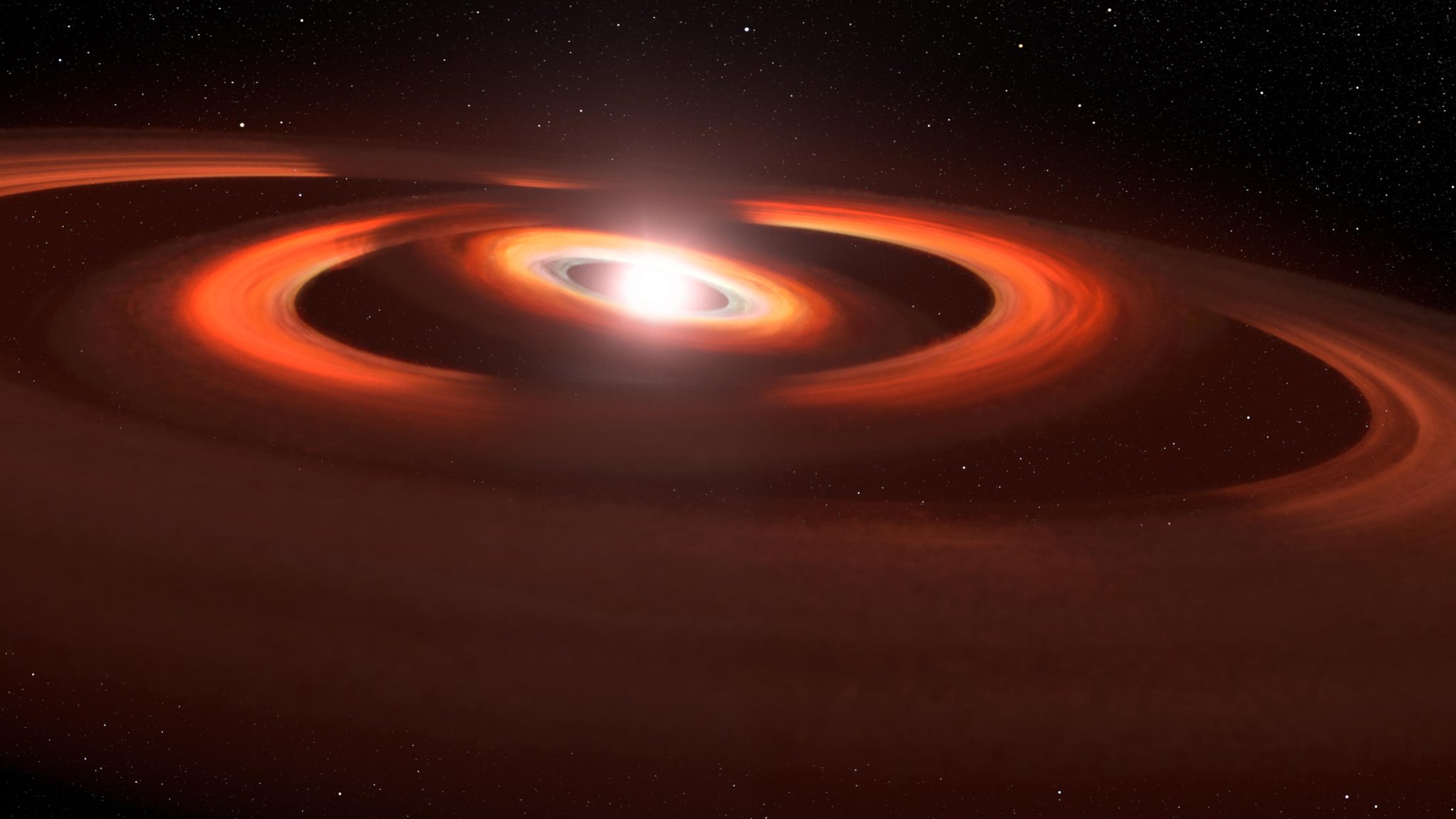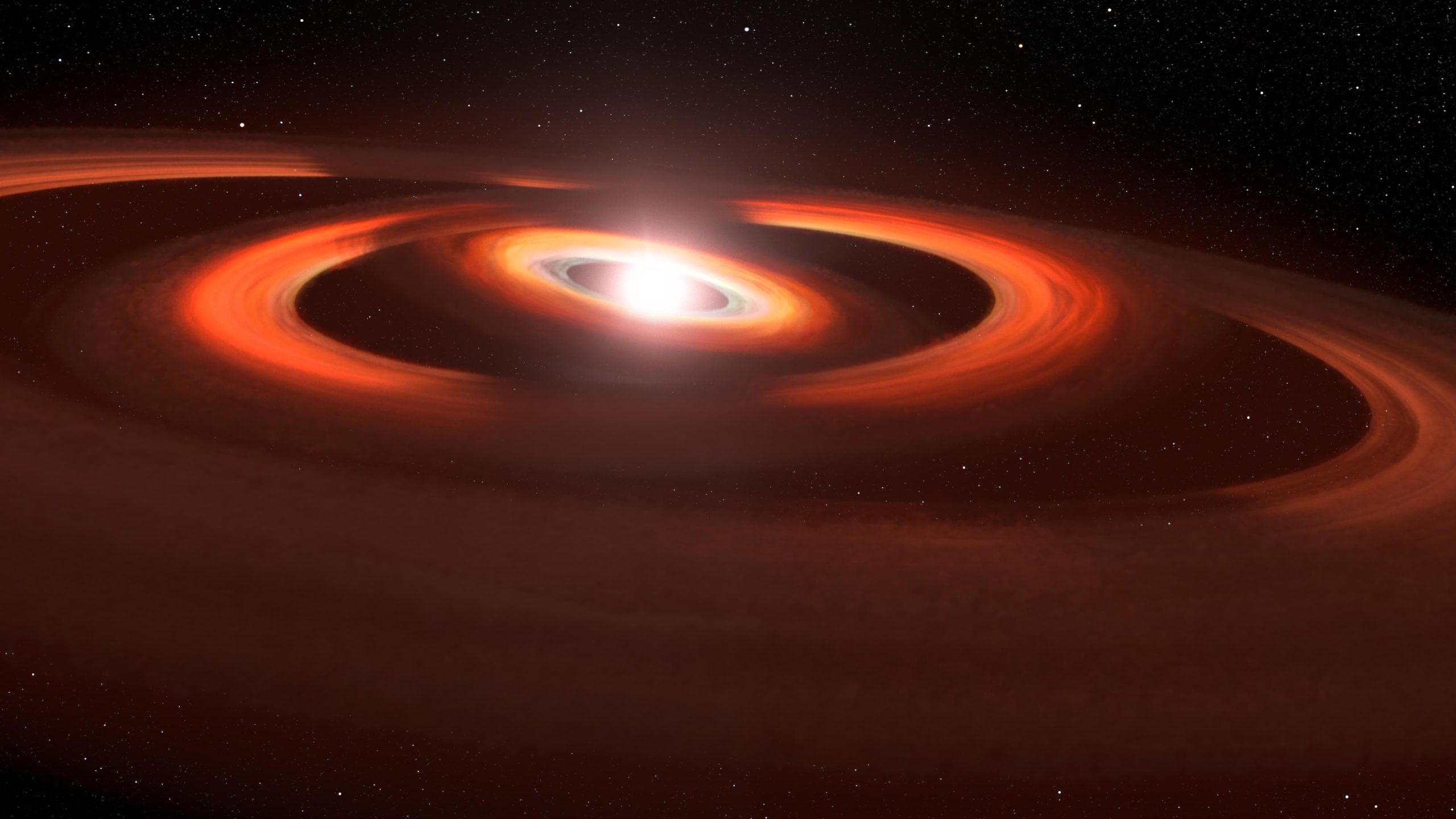
Концепцията на този художник се основава на изображения от космическия телескоп Хъбъл на дискове от газ и прах около младата звезда TW Hydrae. Изображенията на космическия телескоп Хъбъл показват сенки, поглъщащи дисковете, които заобикалят системата. Обяснението е, че тези сенки идват от леко наклонени вътрешни дискове, които пречат на звездната светлина да достигне външния диск, като по този начин хвърлят сянка. Дисковете са леко наклонени един към друг поради гравитационната сила на невидимите планети, които изкривяват структурата на диска. С уважение към: НАСА, Aura/STScI, Европейска космическа агенция, Лия Хостак (STScI)
Невидими новородени планети вдигат прах около млада звезда
Нашият свят е толкова непостоянен, че понякога обича да играе на криеница. През 2017 г. астрономите бяха изненадани да видят огромна сянка, поглъщаща диск от прах и газ около близката млада звезда TW Hydrae. Сянката се хвърля от вътрешен диск от прах и газ, който е леко наклонен спрямо равнината на външния диск. Сянката може да се види ясно само защото системата е наклонена лице в лице на Земята, което дава на астрономите изглед на диска от птичи поглед, докато сянката се стрелка около диска като стрелка, движеща се на часовник.
Но часовникът има две стрелки (за часове и минути), които се движат с различна скорост. И се оказва, че TW Hydrae също е така. Астрономите използваха Хъбъл, за да намерят втора сянка, излизаща от друг вътрешен диск, наклонен към двата външни диска. Следователно системата изглежда все по-сложна с поне три припокриващи се диска, леко наклонени един спрямо друг. Дисковете са проксита за невидими планети около звездата. Всяка планета привлича материал близо до звездата със своята гравитационна сила и деформира това, което би било идеално плосък диск с форма на палачинка, ако планетите не бяха там. Това не е изненадващо, защото планетите в нашата слънчева система имат орбитални равнини, които се различават по наклон с няколко градуса една от друга. TW Hydrae предоставя на астрономите място до ринга, за да видят как може да е изглеждала нашата слънчева система през годините на нейното формиране.

Сравнителни изображения от космическия телескоп Хъбъл, с разлика от няколко години, разкриха две зловещи сенки, движещи се обратно на часовниковата стрелка през диск от газ и прах, заобикалящ младата звезда TW Hydrae. Дисковете се накланят лице в лице на Земята, като по този начин дават на астрономите изглед от птичи поглед какво се случва около звездата. Лявата снимка, направена през 2016 г., показва само една сянка [A] 11:00 часа е. Тази сянка се хвърля от вътрешен диск, който е леко наклонен спрямо външния диск и блокира звездната светлина. Изображението вляво показва втора сянка, която се е появила от друг междинен диск [C] 7:00 сутринта, както е заснето през 2021 г. Оригинален вътрешен диск, маркиран [B] в това следващо предаване. Сенките се въртят около звездата с различна скорост като по часовниковата стрелка. Те са доказателство за две невидими планети, които са привлекли прах в орбитите си. Това ги кара да се навеждат леко един към друг. Това е изображение във видима светлина, направено със спектрорадиометъра за изображения на космическия телескоп. Добавен е синтетичен цвят за подобряване на детайлите. С уважение към: NASA, ESA, STScI, Джон Дебес (AURA/STScI за ESA), Джоузеф ДеПаскуале (STScI)
Космическият телескоп Хъбъл проследява игра на сенки около планетообразуващия диск
Младата звезда TW Hydrae играе „кукли в сянка“ с учените, които го наблюдават[{“ attribute=““>NASA’s Hubble Space Telescope.
In 2017, astronomers reported discovering a shadow sweeping across the face of a vast pancake-shaped gas-and-dust disk surrounding the red dwarf star. The shadow isn’t from a planet, but from an inner disk slightly inclined relative to the much larger outer disk – causing it to cast a shadow. One explanation is that an unseen planet’s gravity is pulling dust and gas into the planet’s inclined orbit.
Now, a second shadow – playing a game of peek-a-boo – has emerged in just a few years between observations stored in Hubble’s MAST archive. This could be from yet another disk nestled inside the system. The two disks are likely evidence of a pair of planets under construction.
TW Hydrae is less than 10 million years old and resides about 200 light-years away. In its infancy, our solar system may have resembled the TW Hydrae system, some 4.6 billion years ago. Because the TW Hydrae system is tilted nearly face-on to our view from Earth, it is an optimum target for getting a bull’s-eye-view of a planetary construction yard.
The second shadow was discovered in observations obtained on June 6, 2021, as part of a multi-year program designed to track the shadows in circumstellar disks. John Debes of AURA/STScI for the European Space Agency at the Space Telescope Science Institute in Baltimore, Maryland, compared the TW Hydrae disk to Hubble observations made several years ago.
“We found out that the shadow had done something completely different,” said Debes, who is principal investigator and lead author of the study published in The Astrophysical Journal. “When I first looked at the data, I thought something had gone wrong with the observation because it wasn’t what I was expecting. I was flummoxed at first, and all my collaborators were like: what is going on? We really had to scratch our heads and it took us a while to actually figure out an explanation.”
The best solution the team came up with is that there are two misaligned disks casting shadows. They were so close to each other in the earlier observation they were missed. Over time they’ve now separated and split into two shadows. “We’ve never really seen this before on a protoplanetary disk. It makes the system much more complex than we originally thought,” he said.
The simplest explanation is that the misaligned disks are likely caused by the gravitational pull of two planets in slightly different orbital planes. Hubble is piecing together a holistic view of the architecture of the system.
The disks may be proxies for planets that are lapping each other as they whirl around the star. It’s sort of like spinning two vinyl phonograph records at slightly different speeds. Sometimes labels will match up but then one gets ahead of the other.
“It does suggest that the two planets have to be fairly close to each other. If one was moving much faster than the other, this would have been noticed in earlier observations. It’s like two race cars that are close to each other, but one slowly overtakes and laps the other,” said Debes.
The suspected planets are located in a region roughly the distance of Jupiter from our Sun. And, the shadows complete one rotation around the star about every 15 years – the orbital period that would be expected at that distance from the star.
Also, these two inner disks are inclined about five to seven degrees relative to the plane of the outer disk. This is comparable to the range of orbital inclinations inside our solar system. “This is right in line with typical solar system style architecture,” said Debes.
The outer disk that the shadows are falling on may extend as far as several times the radius of our solar system’s Kuiper belt. This larger disk has a curious gap at twice Pluto’s average distance from the Sun. This might be evidence for a third planet in the system.
Any inner planets would be difficult to detect because their light would be lost in the glare of the star. Also, dust in the system would dim their reflected light. ESA’s Gaia space observatory may be able to measure a wobble in the star if Jupiter-mass planets are tugging on it, but this would take years given the long orbital periods.
The TW Hydrae data are from Hubble’s Space Telescope Imaging Spectrograph. The James Webb Space Telescope’s infrared vision may also be able to show the shadows in more detail.
Reference: “The Surprising Evolution of the Shadow on the TW Hya Disk” by John Debes, Rebecca Nealon, Richard Alexander, Alycia J. Weinberger, Schuyler Grace Wolff, Dean Hines, Joel Kastner, Hannah Jang-Condell, Christophe Pinte, Peter Plavchan and Laurent Pueyo, 4 May 2023, The Astrophysical Journal.
DOI: 10.3847/1538-4357/acbdf1
The Hubble Space Telescope is a project of international cooperation between NASA and ESA. NASA’s Goddard Space Flight Center in Greenbelt, Maryland, manages the telescope. The Space Telescope Science Institute (STScI) in Baltimore conducts Hubble science operations. STScI is operated for NASA by the Association of Universities for Research in Astronomy, in Washington, D.C.

„Тотален фен на Twitter. Нежно очарователен почитател на бекона. Сертифициран специалист по интернет.“





More Stories
„Треска на ленивец“ или Оровирус навлезе в Съединените щати от Куба – ето какво трябва да знаете
Идентични следи от стъпки на динозаври открити на два континента
Най-мощният телескоп на Земята заснема изображения на черни дупки с безпрецедентни детайли